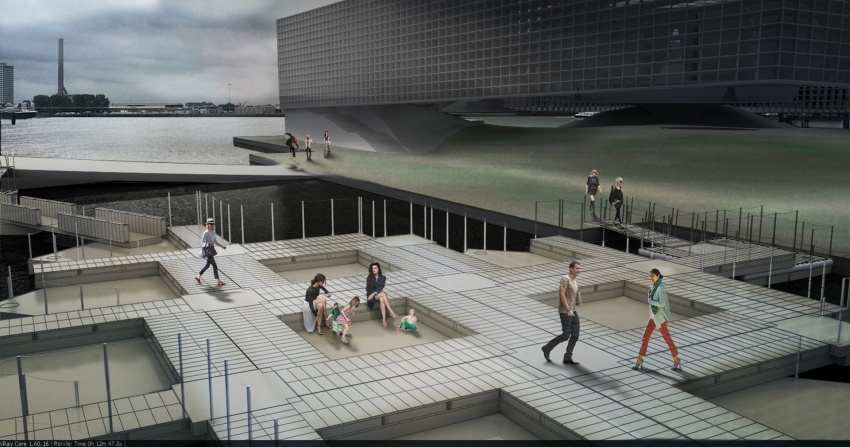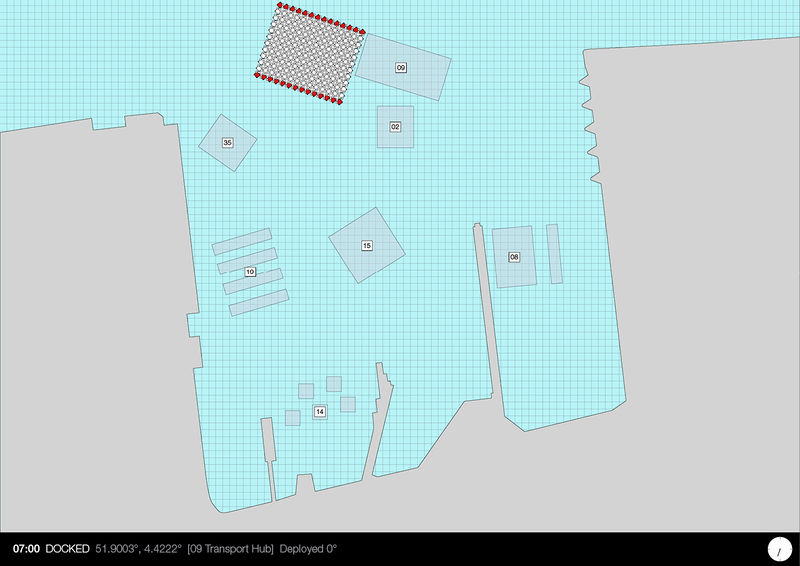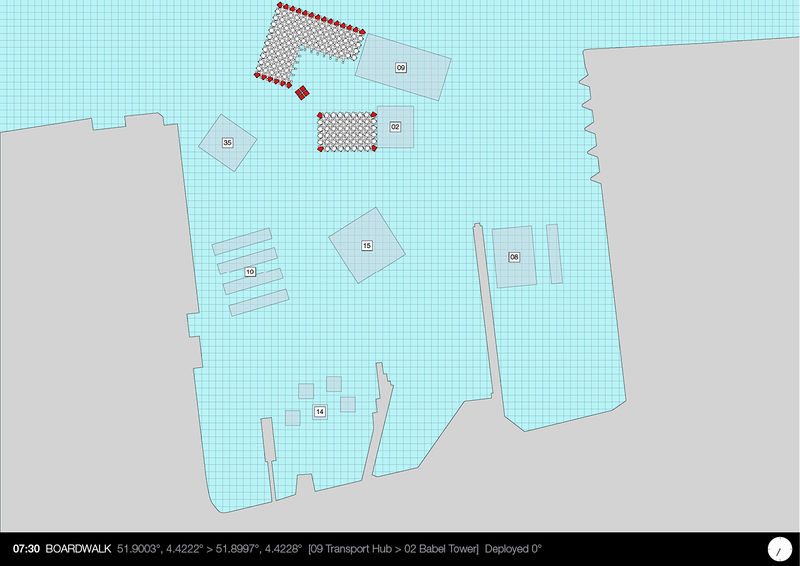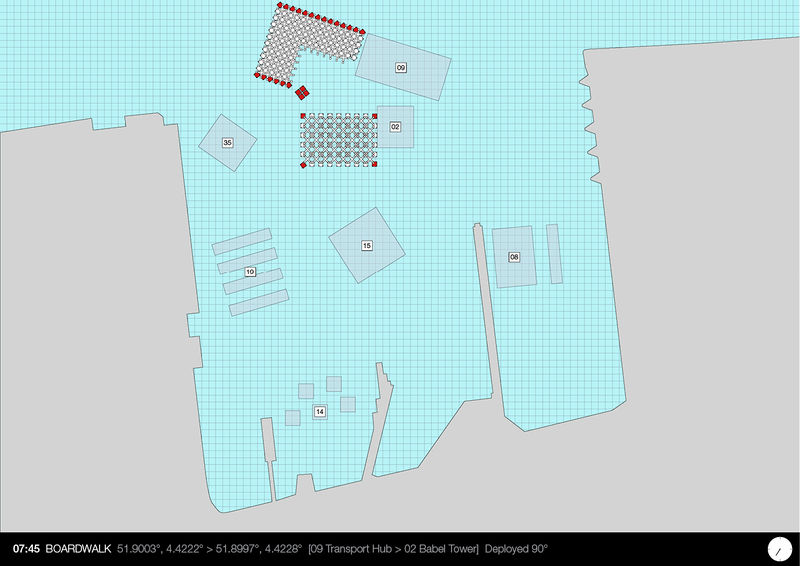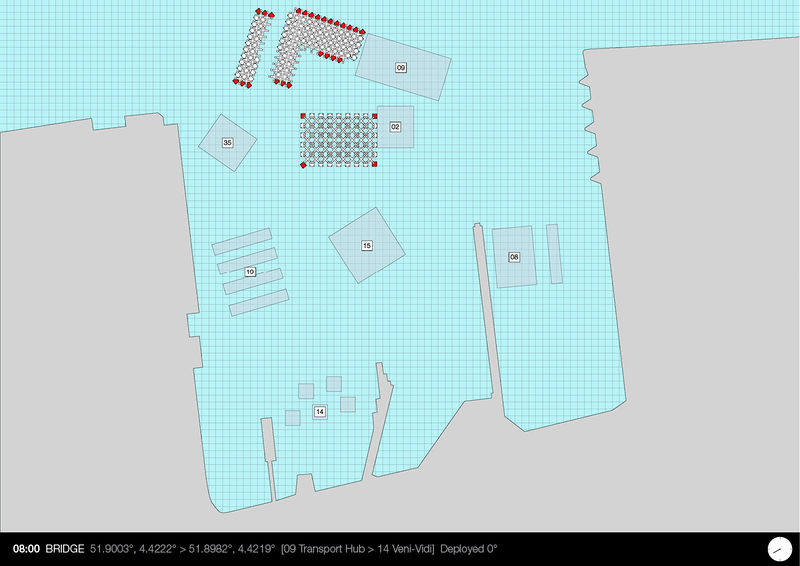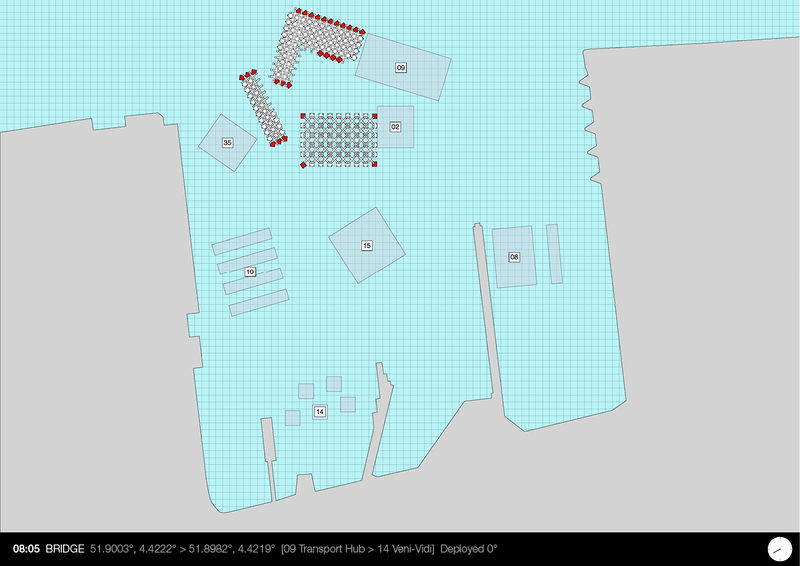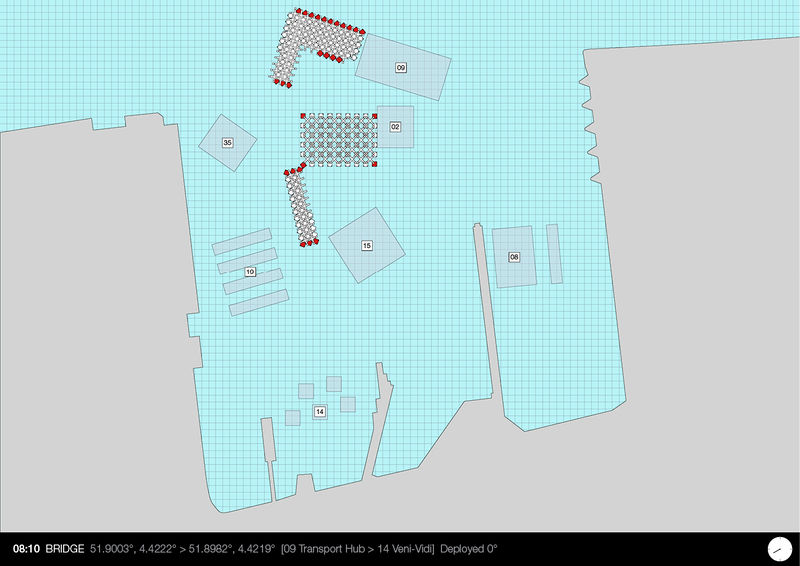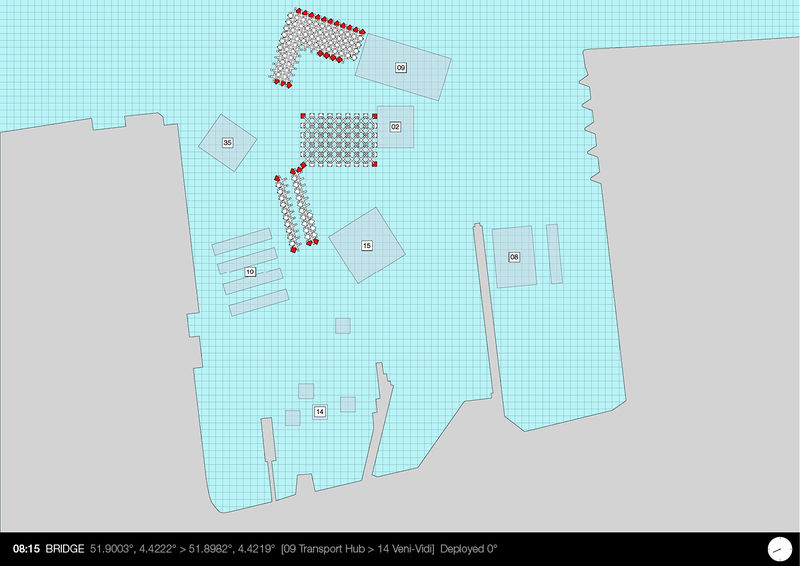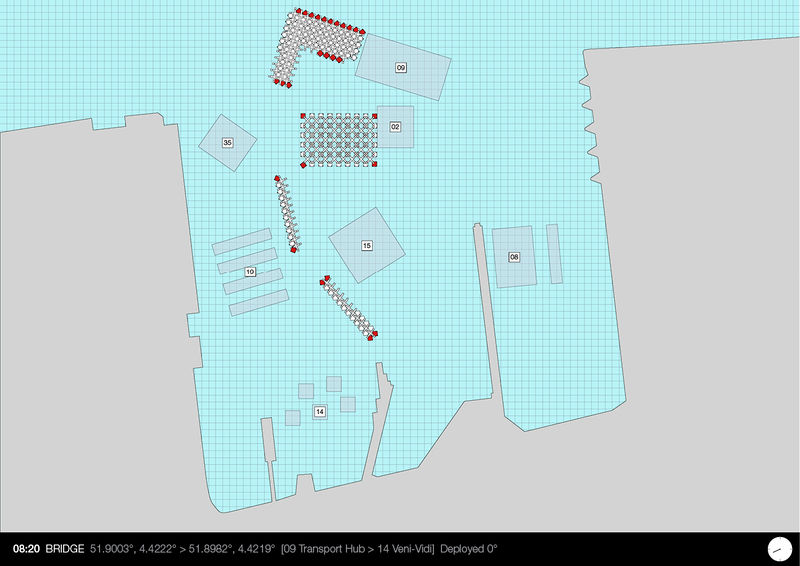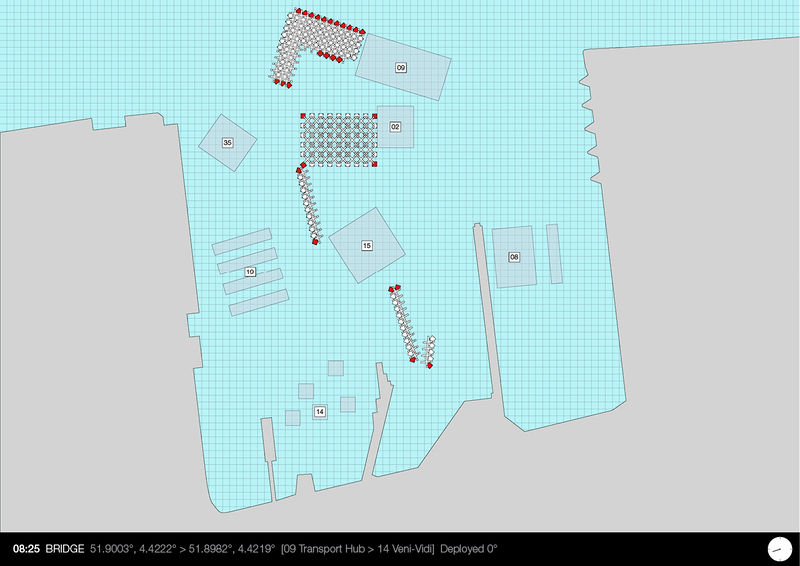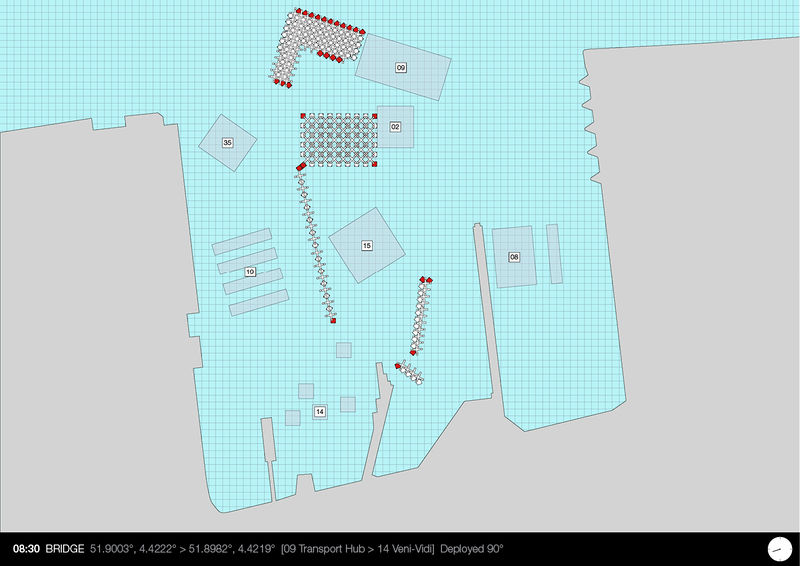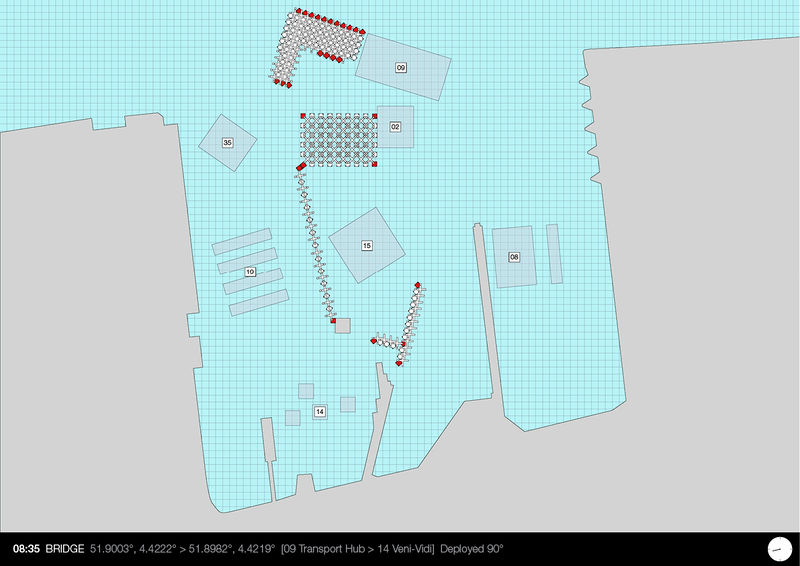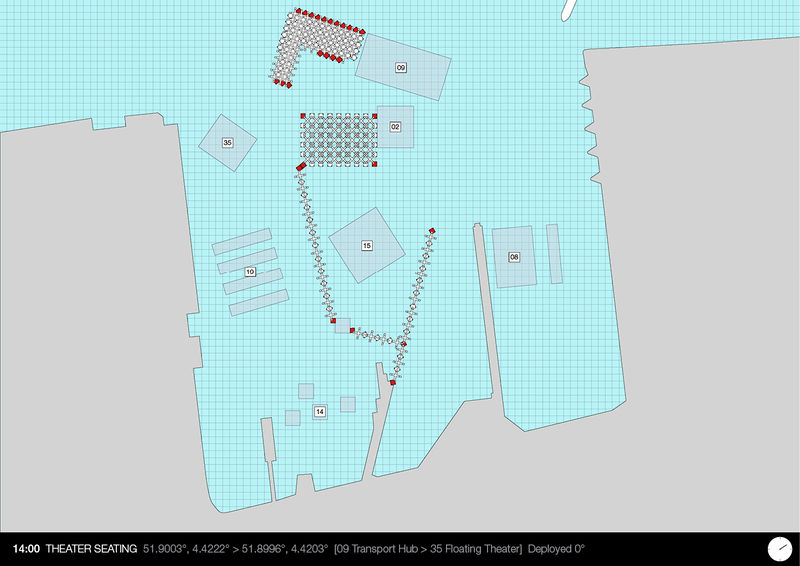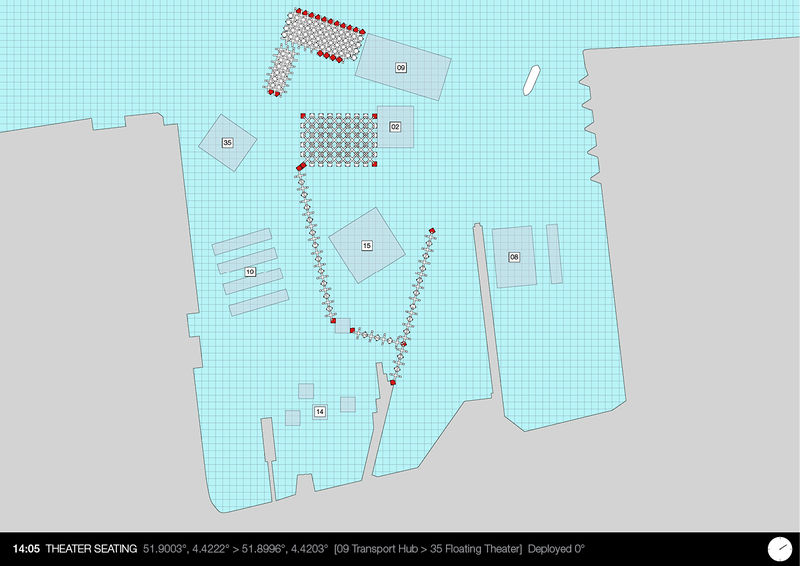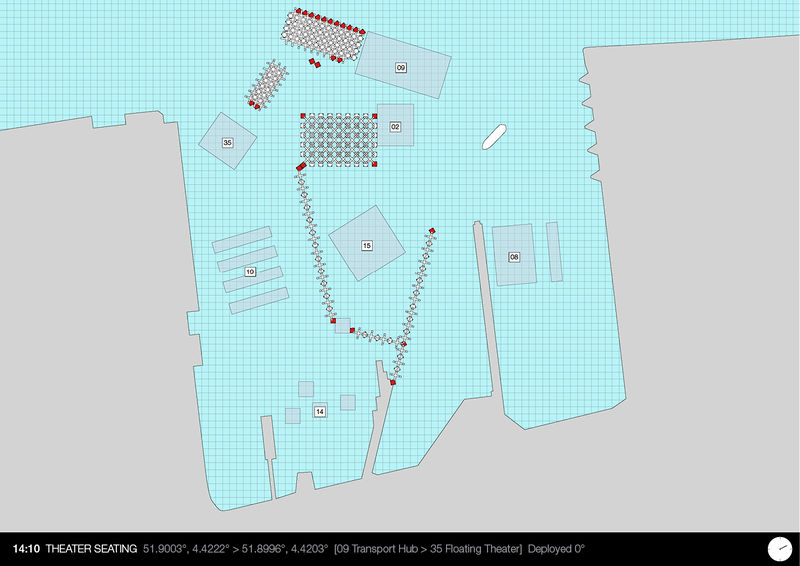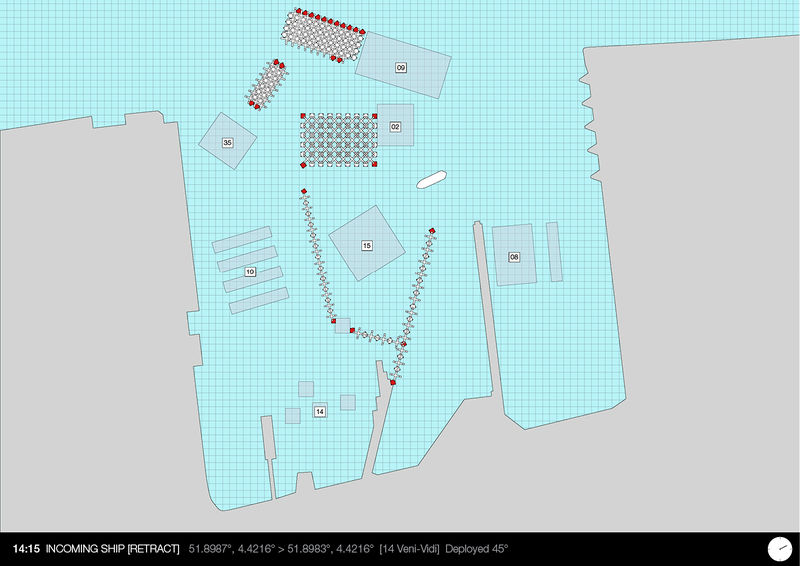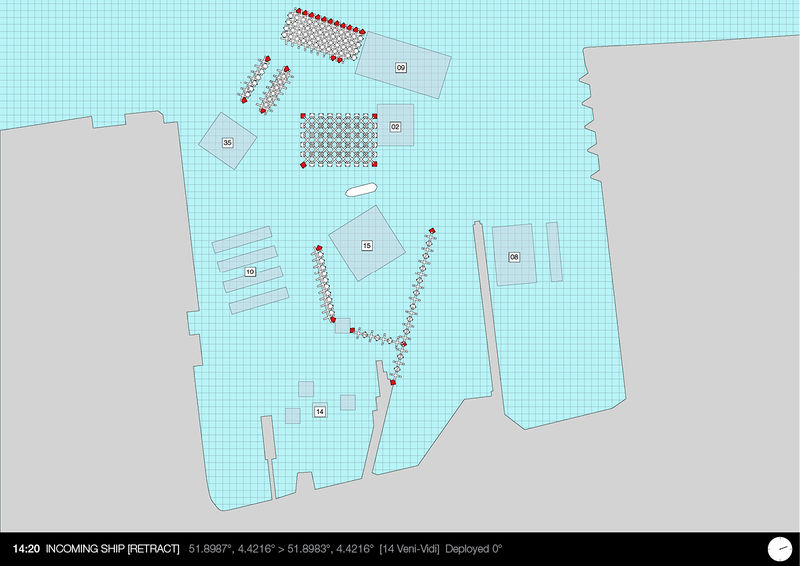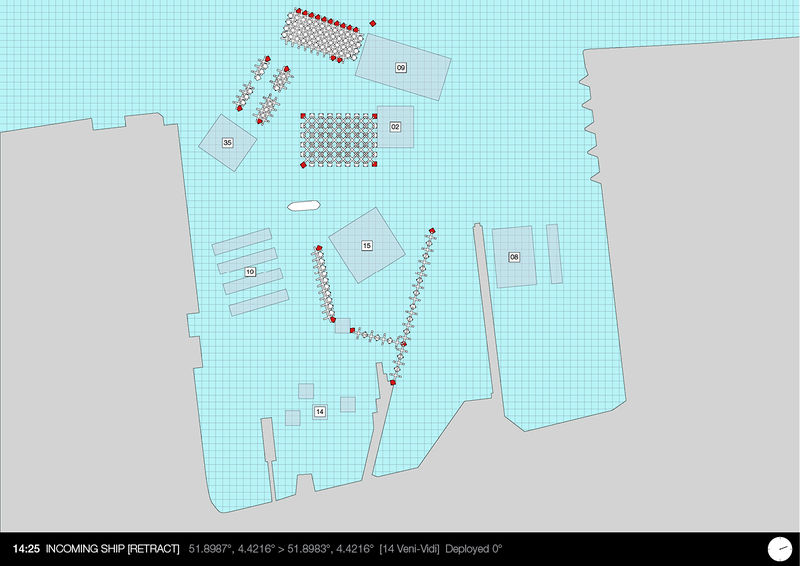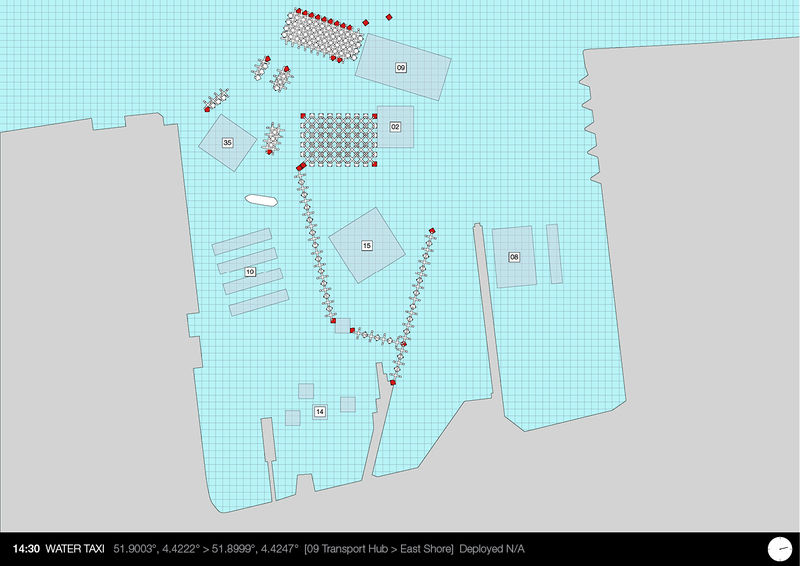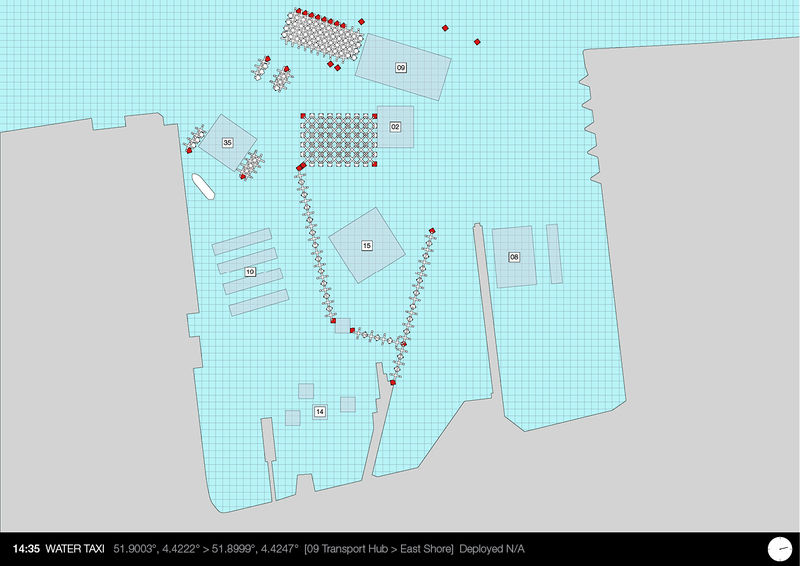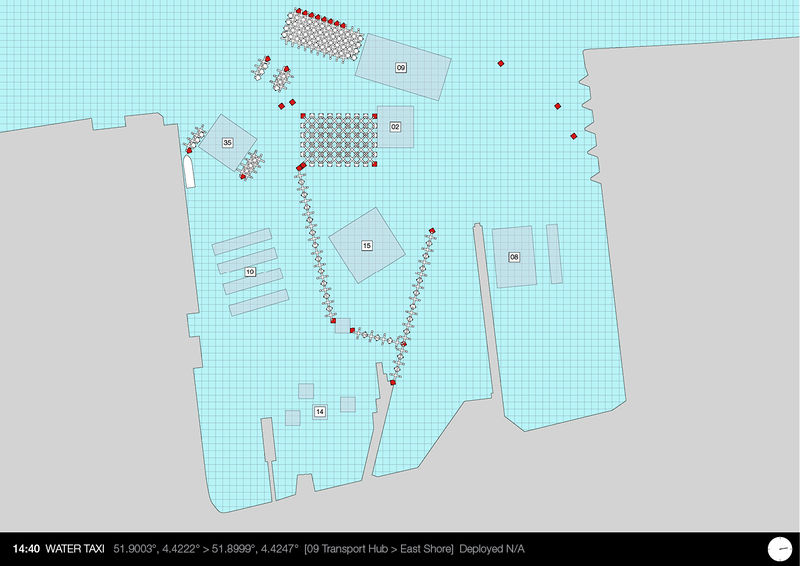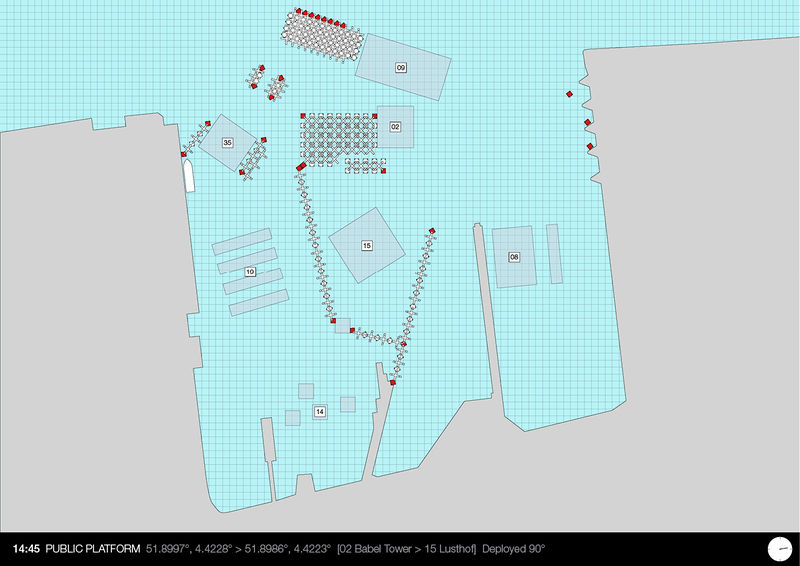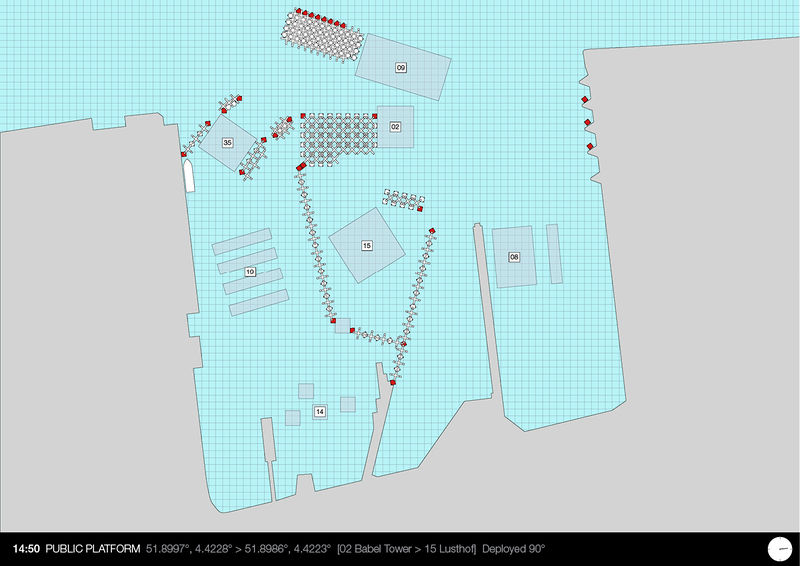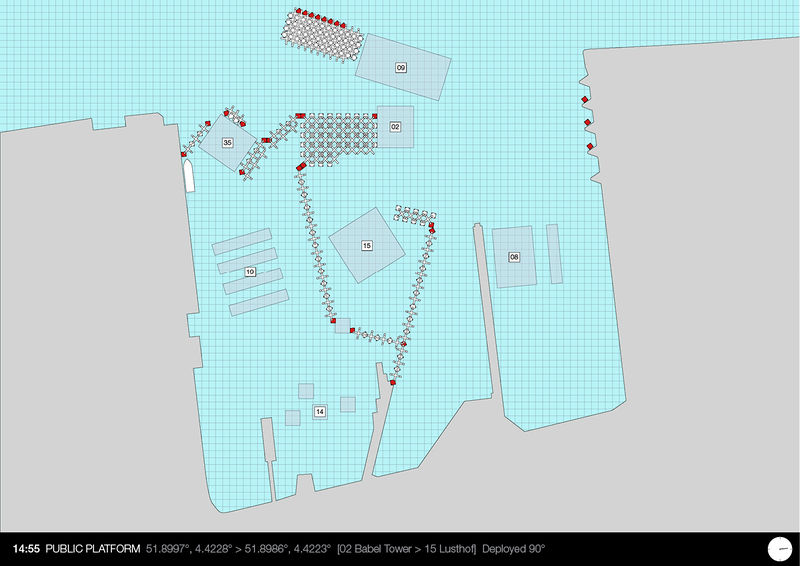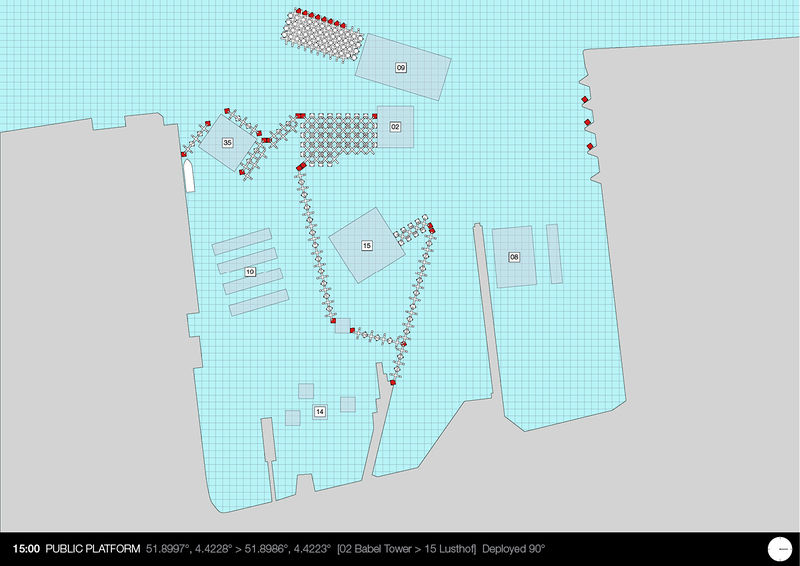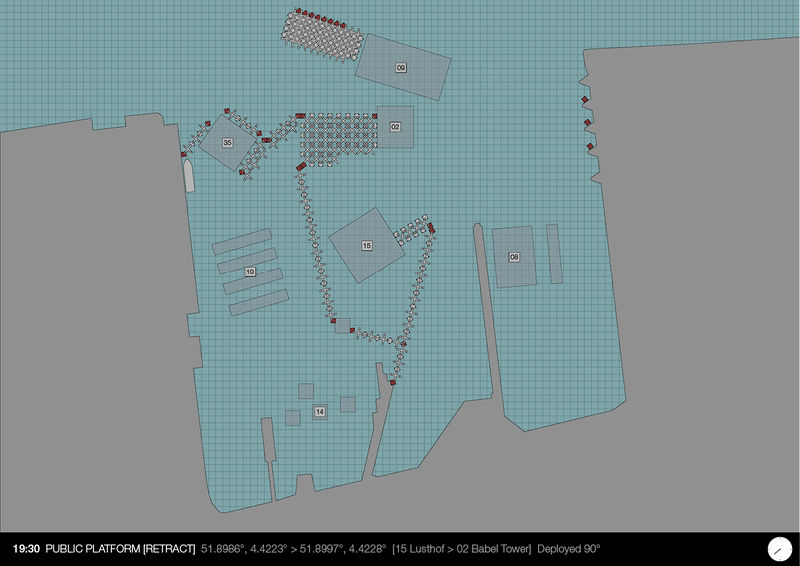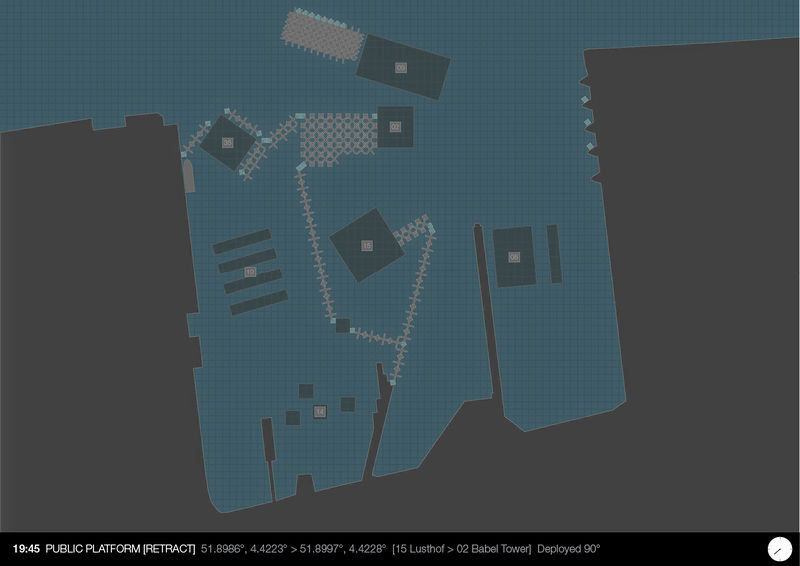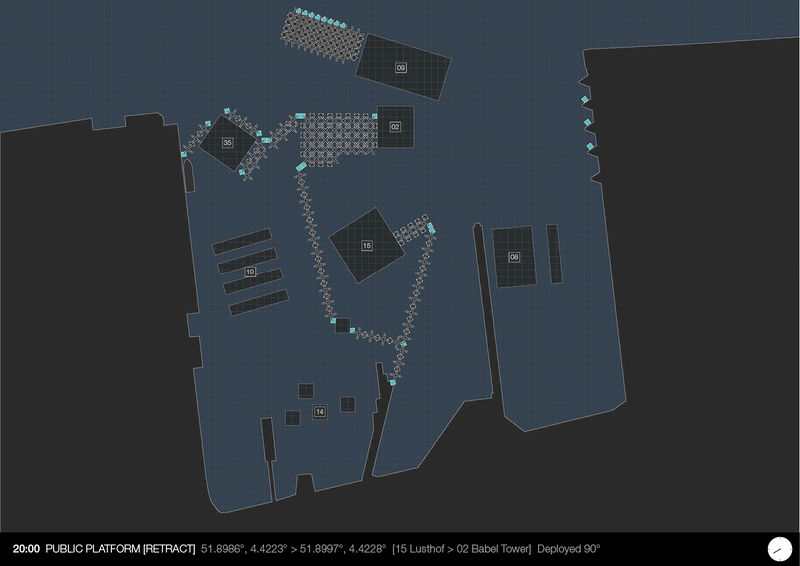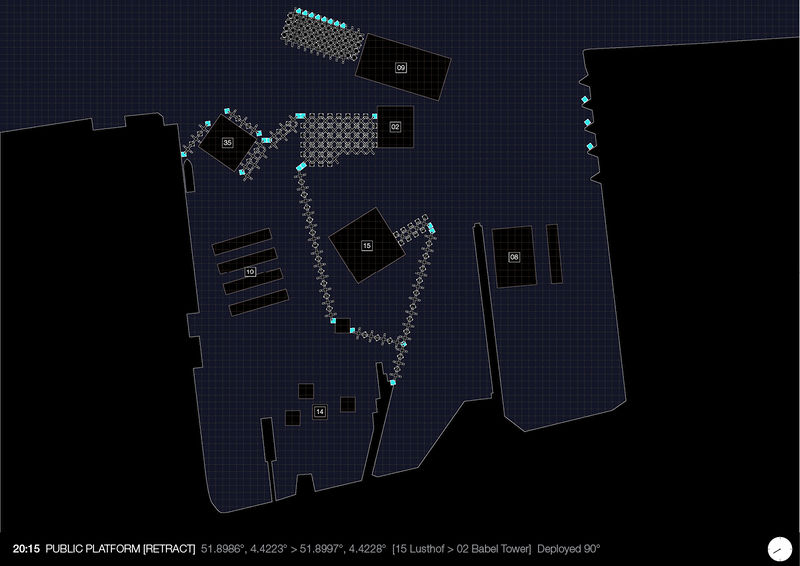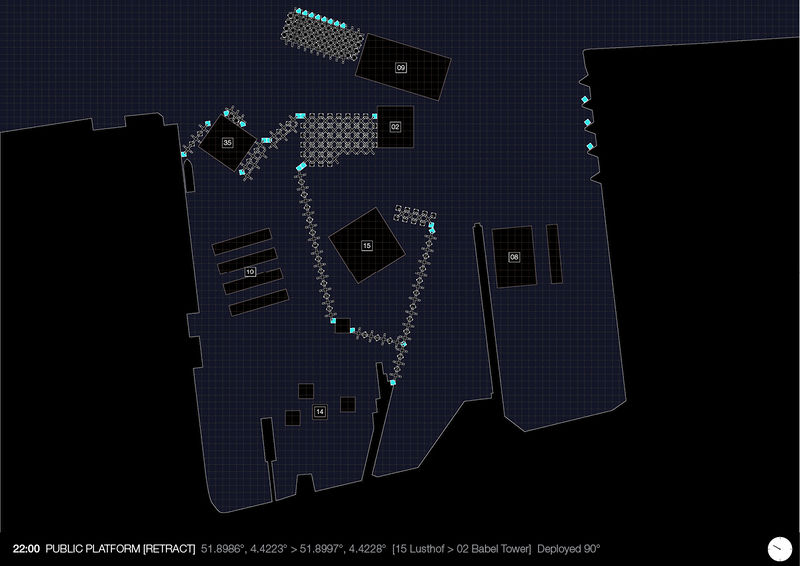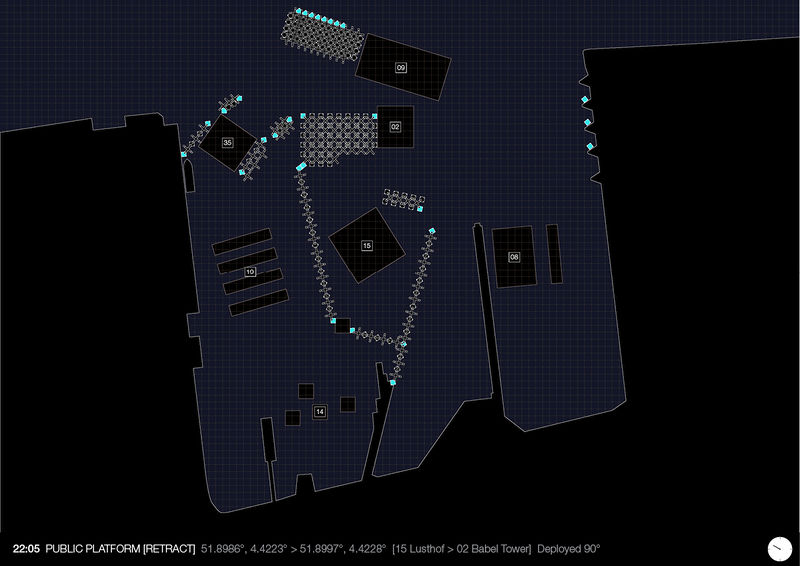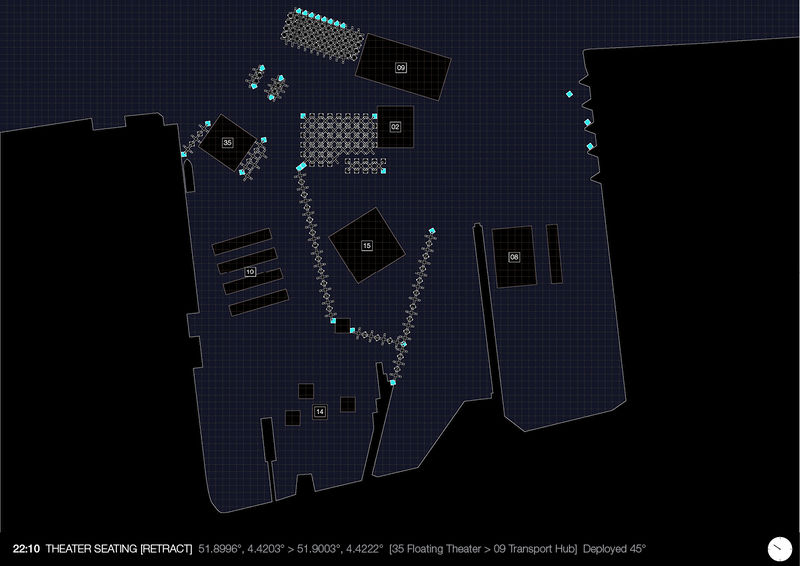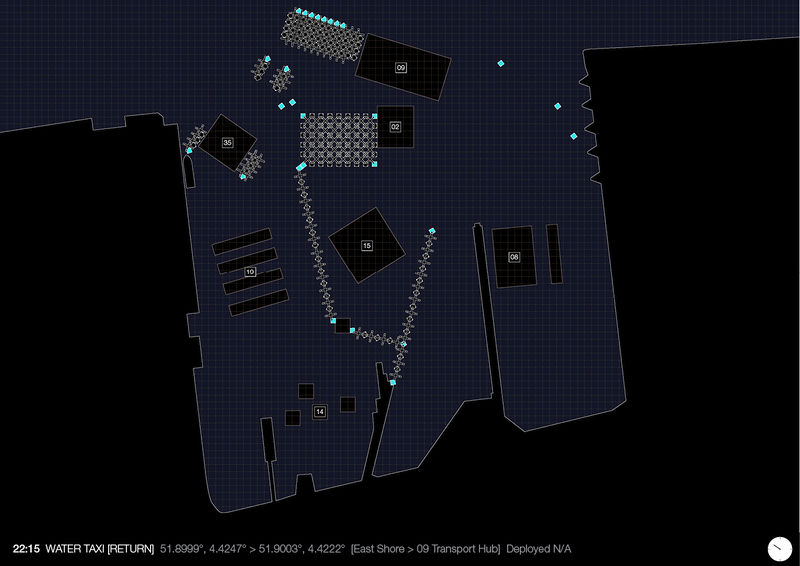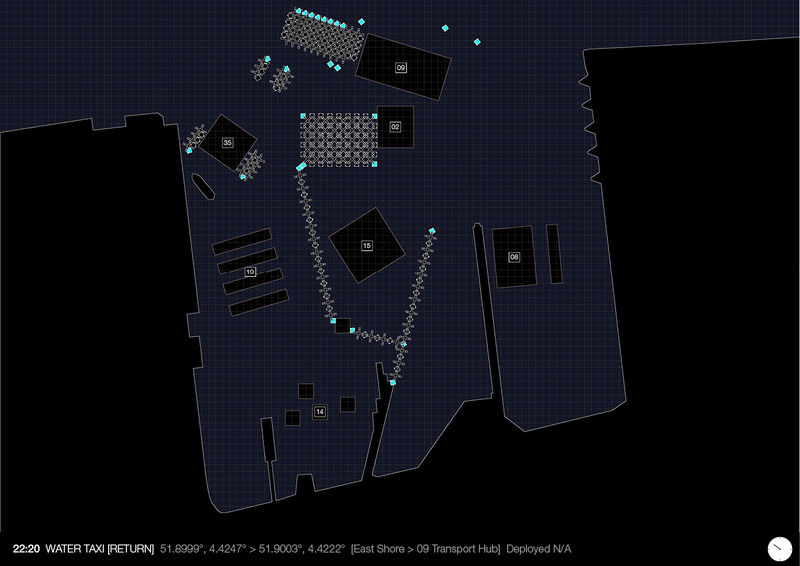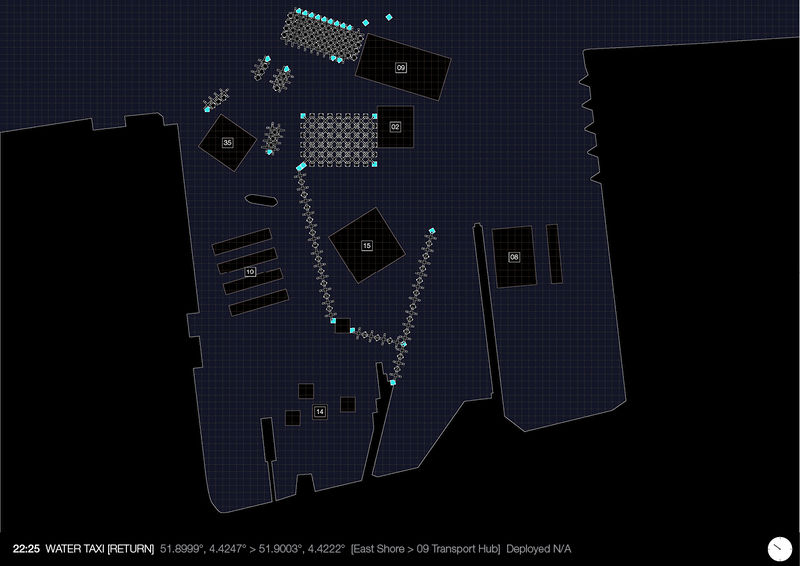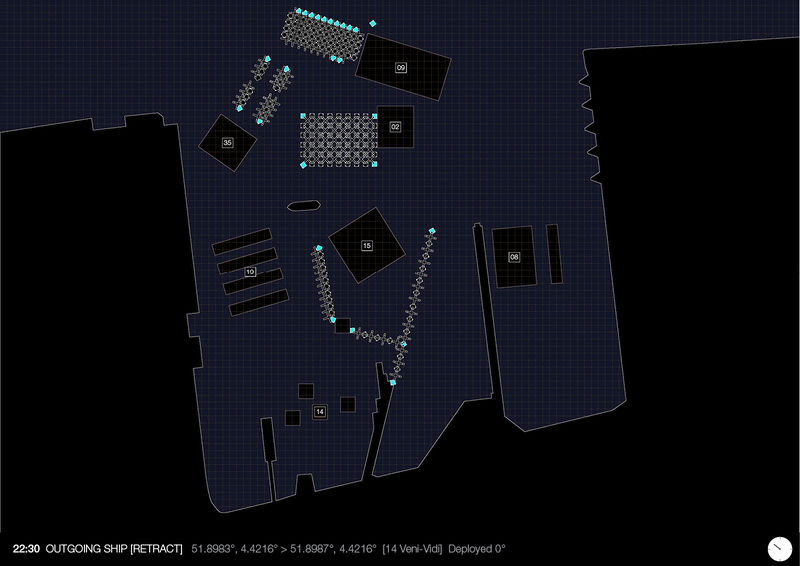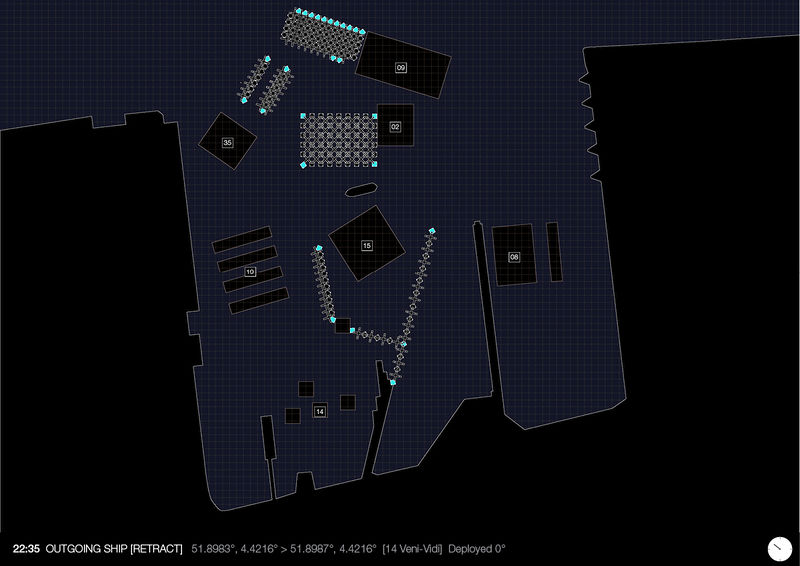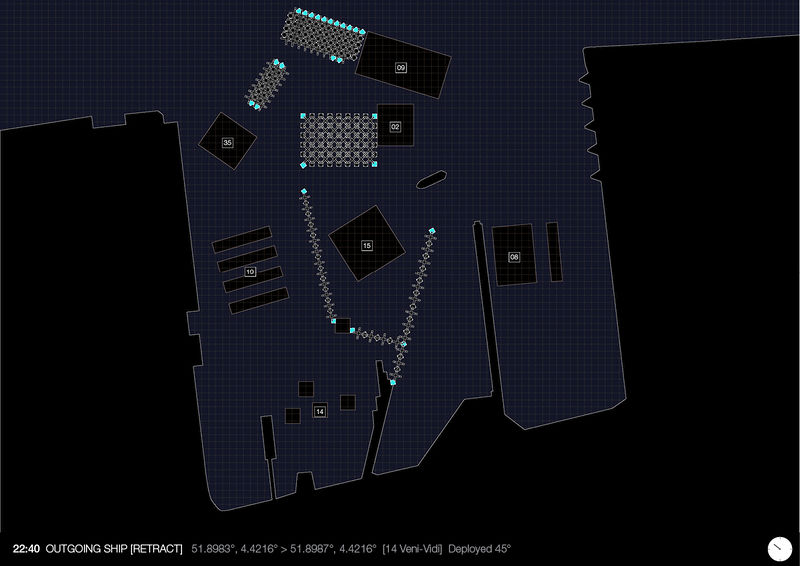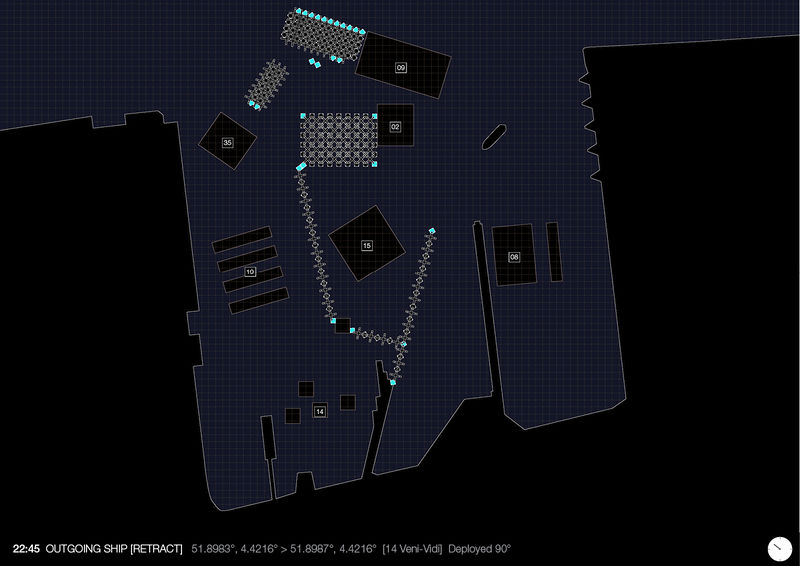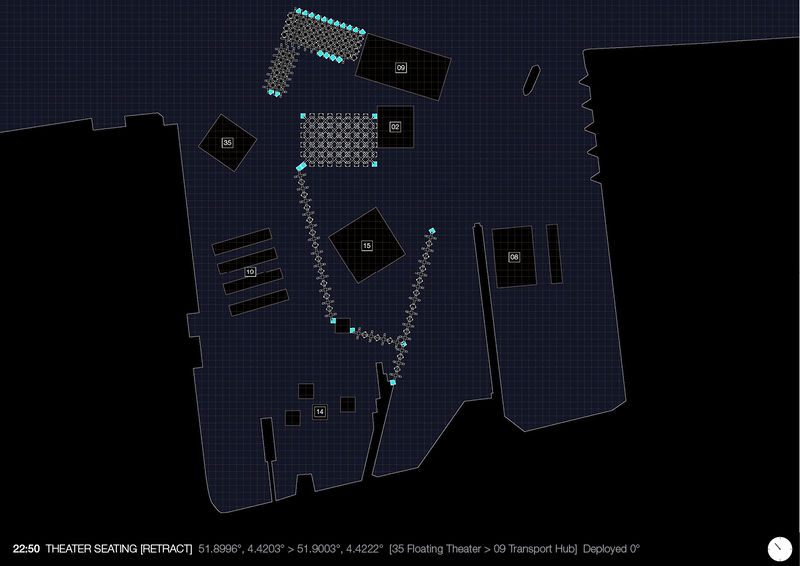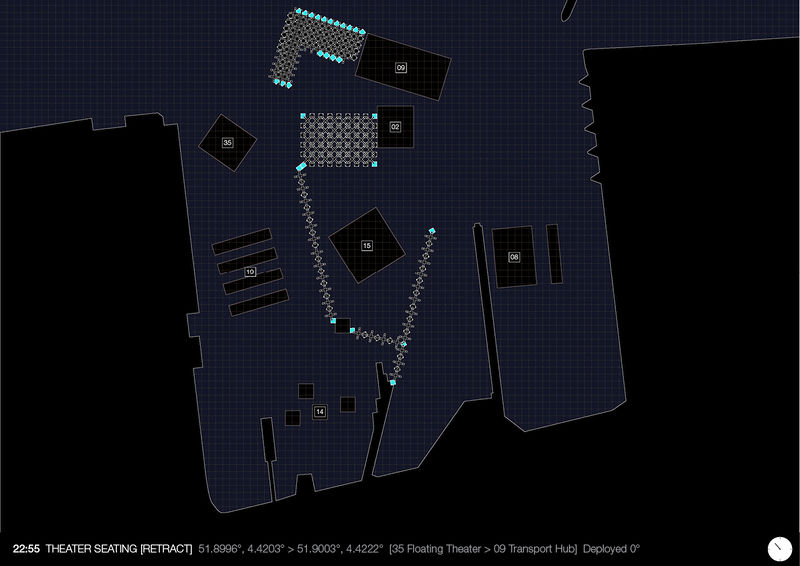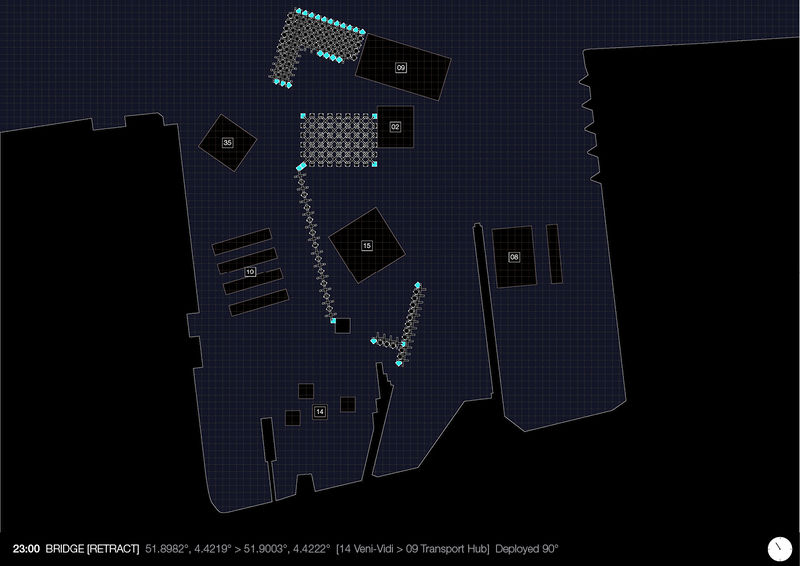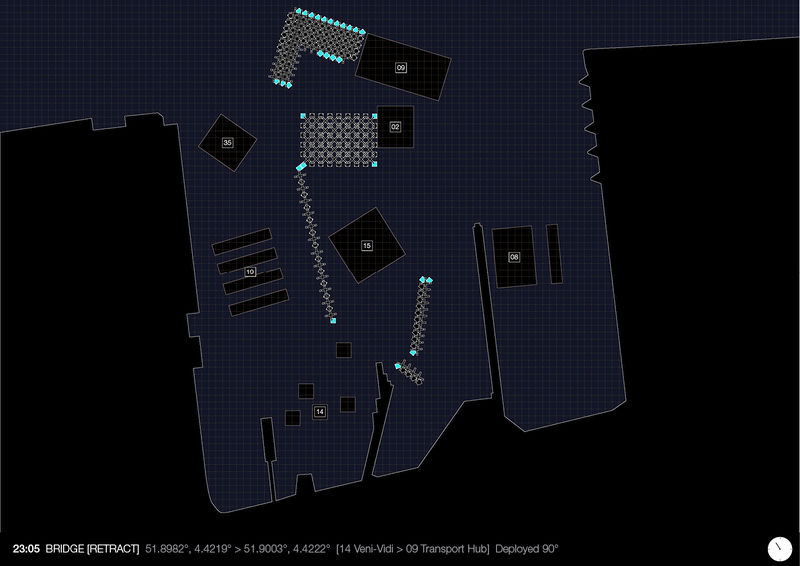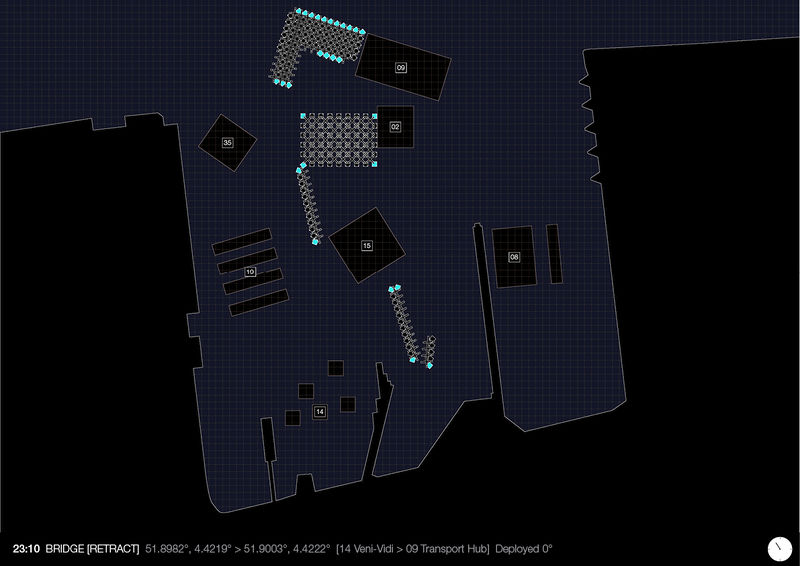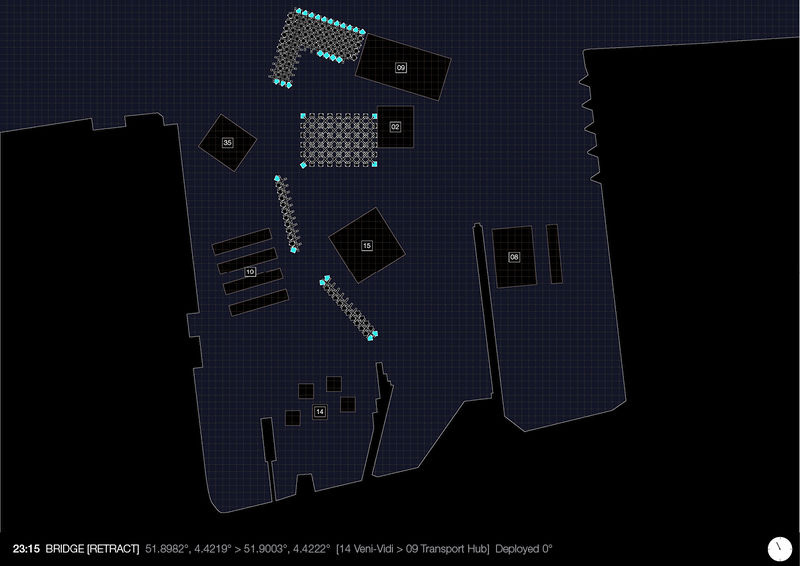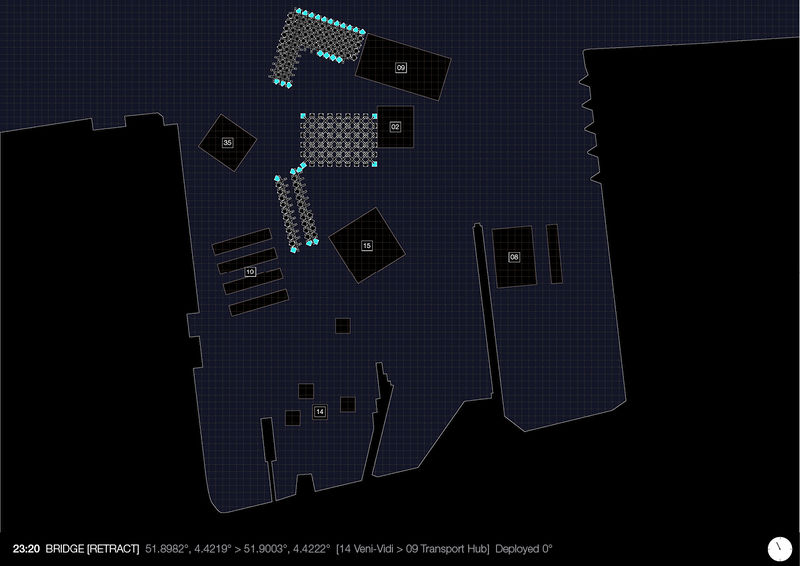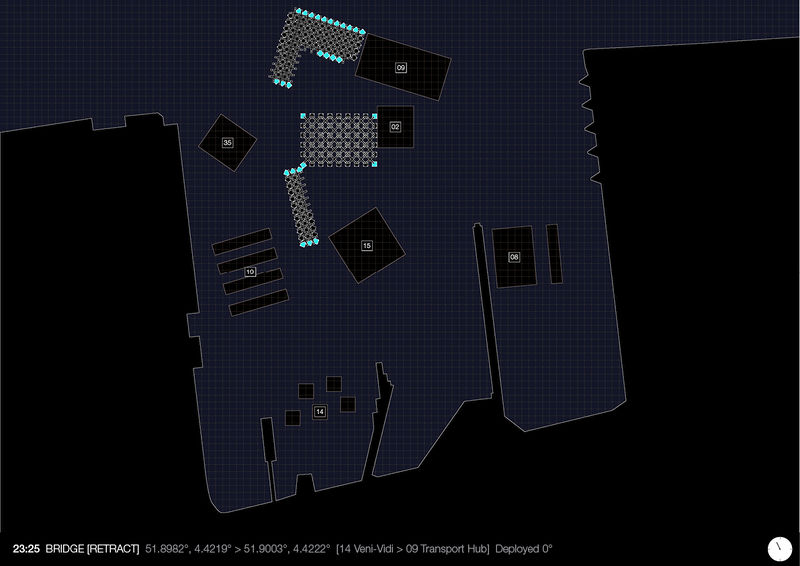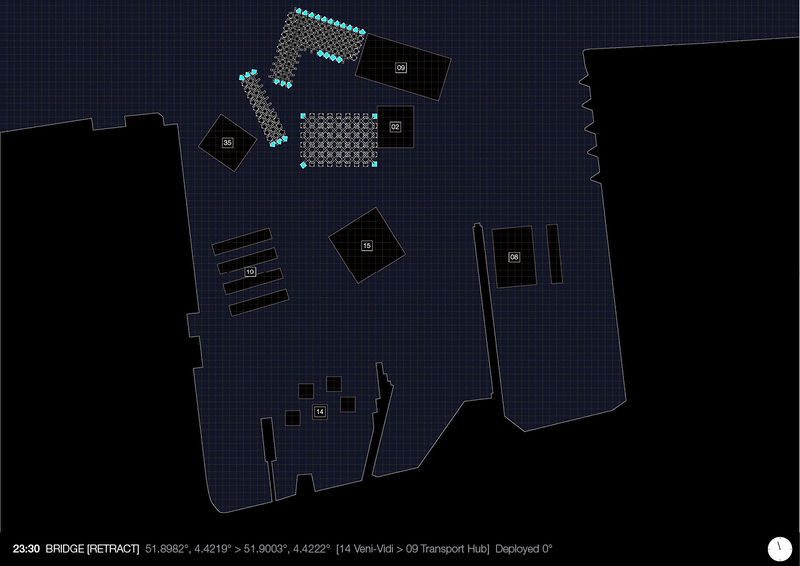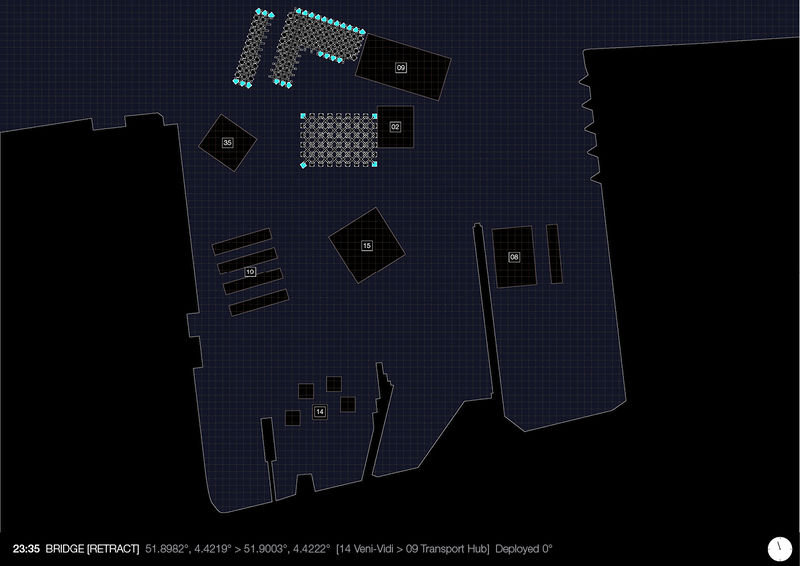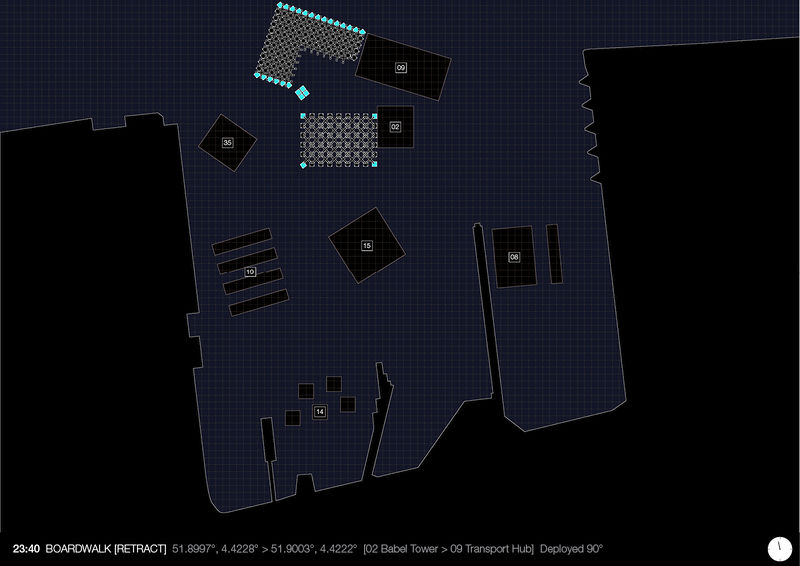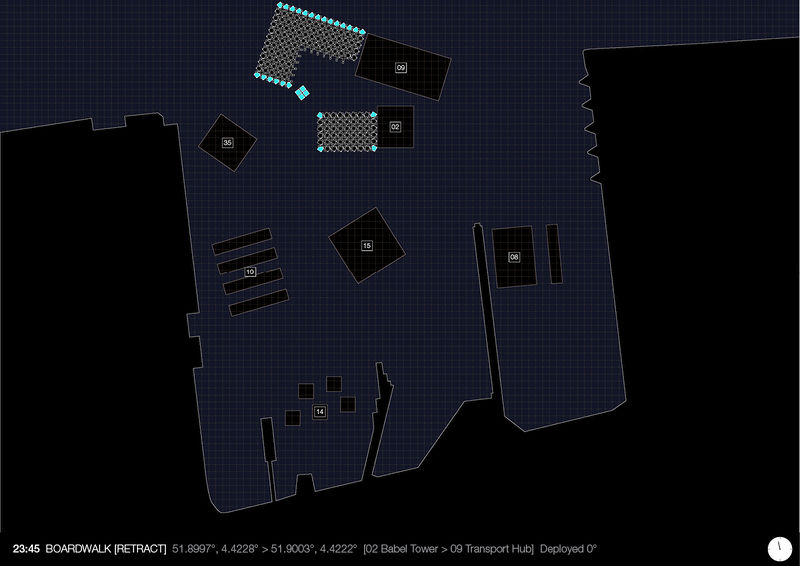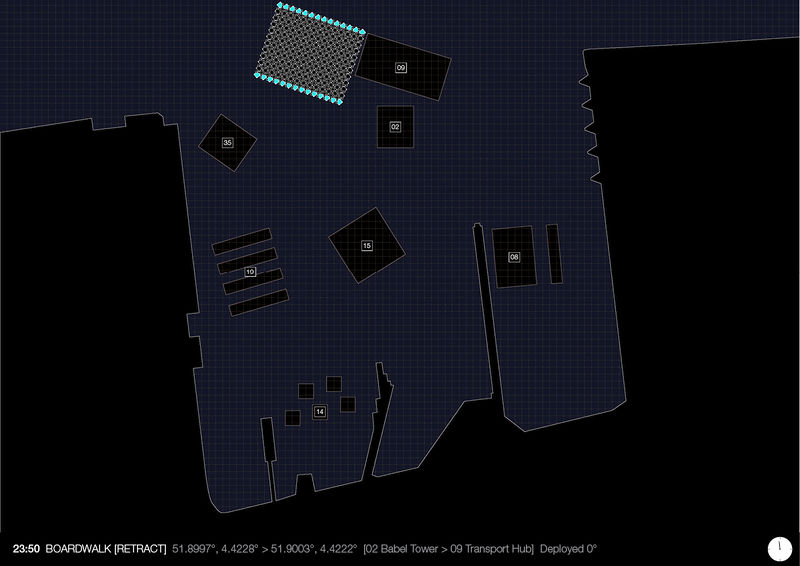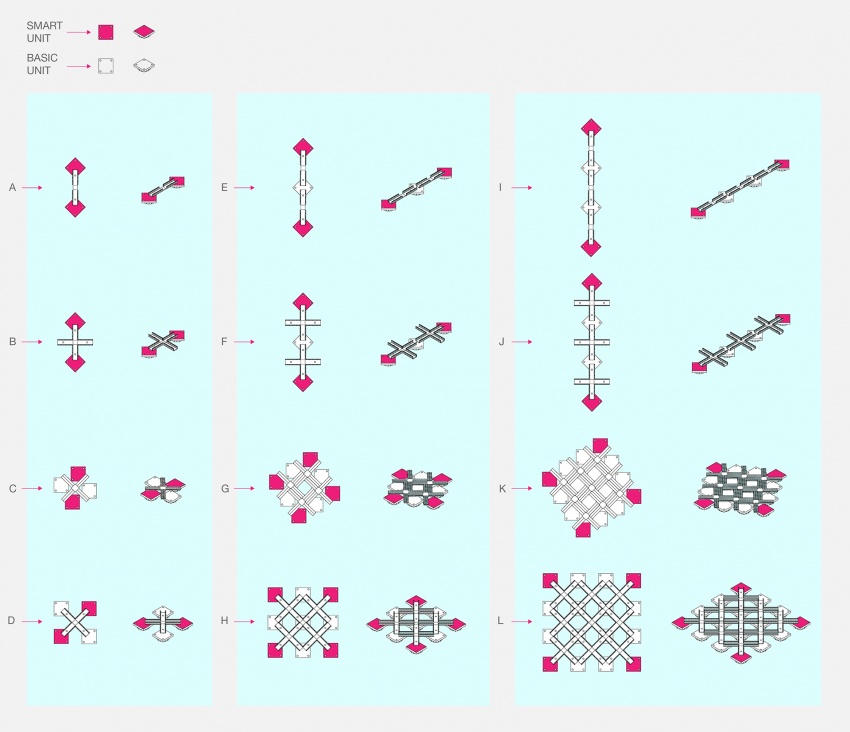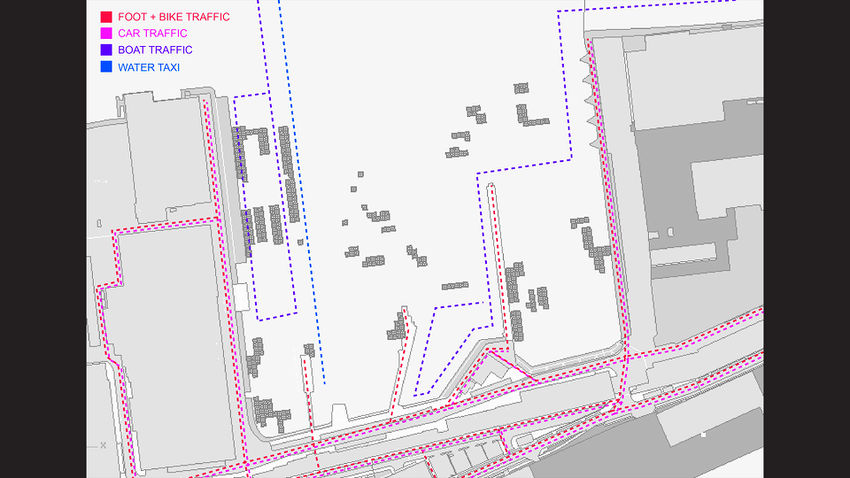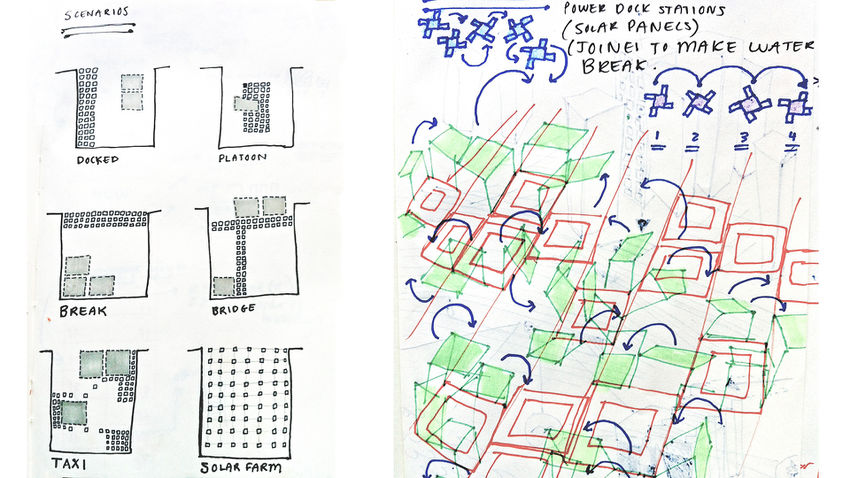project23:Interactions
| (2 intermediate revisions by one user not shown) | |||
| Line 1: | Line 1: | ||
| + | == '''RDM Harbor: Site Interactions''' == | ||
| + | |||
| + | As a flexible mechanism, the Deployable Bridge can connect any points in the RDM harbor, providing a crucial link between water and shoreline. The system can forge temporary links where desired, regardless of activity or function, allowing people to cross the harbour freely in a multitude of configurations. By serving as a link between different modes of transit on site (bikes, ferries, personal watercraft, etc.), the bridge supports a range of transit scales. It can function as an individual unit or as a multiple, mass configuration of units. Strengths vary according to scale. | ||
| + | |||
== '''Deployable Bridge Connections''' == | == '''Deployable Bridge Connections''' == | ||
| Line 5: | Line 9: | ||
The bridge consists of floating square-shaped platform units (◘) and 4-part pathway units (✚). Platform units (◘) are either basic units or smart units (denoted here in red). Smart units are equipped with 4 directional thrusters and the capacity to send and receive information and instructions. Smart units are positioned on all corners of a field of basic units (or on both ends of a line of basic units) to effectively rotate and deploy the basic units. This allows for the freedom of any kind of arrangement and formation according to user needs. | The bridge consists of floating square-shaped platform units (◘) and 4-part pathway units (✚). Platform units (◘) are either basic units or smart units (denoted here in red). Smart units are equipped with 4 directional thrusters and the capacity to send and receive information and instructions. Smart units are positioned on all corners of a field of basic units (or on both ends of a line of basic units) to effectively rotate and deploy the basic units. This allows for the freedom of any kind of arrangement and formation according to user needs. | ||
| + | |||
| + | <div style="width: 850px; height: 460px; margin: 0; padding: 0px; overflow: hidden;"> | ||
| + | [[File:PROJECT23 Render01.jpg|850px]] | ||
| + | </div> | ||
| + | == '''Docking''' == | ||
| + | |||
| + | In order to securely connect to boats, the shoreline, and other projects on the RDM site, the Deployable Bridge utilizes aluminum or galvanized iron cleats. The cleats are bolted into galvanized steel angles for optimal strength. Smart units are equipped with a 2-meter deployable gangway to bridge any discrepancies in elevation, in addition to an optional weighted anchor. | ||
| + | |||
| + | |||
| + | == '''24-Hour Time Lapse: RDM Harbor''' == | ||
| + | |||
| + | This animation provides one possible overview of a 24-hour time lapse of the RDM Harbor site. The functional capacities of the bridge are listed by each time frame, in accordance with different projects located on the site. Different scenarios require different formations, necessitating a wide range of possible surface areas and various speeds for different scales of transit. The bridge can also support other projects by providing additional public platforms, circulation routes, and seating. | ||
{{#slideshow: | {{#slideshow: | ||
| Line 64: | Line 80: | ||
| − | + | == '''Deployable Bridge: Catalogue of Formations''' == | |
| − | + | ||
| − | + | ||
| − | + | ||
| − | + | ||
| − | + | ||
| − | + | ||
| − | + | ||
| − | + | ||
The bridge can be configured to connect projects on-site with any point along the shoreline, or any boat or water taxi on water. The path of the bridge can be defined and reconfigured by users with different needs, allowing users to participate and interact with the transit system in line with personal preferences. Pedestrians no longer need to circumnavigate the harbor on dry land. | The bridge can be configured to connect projects on-site with any point along the shoreline, or any boat or water taxi on water. The path of the bridge can be defined and reconfigured by users with different needs, allowing users to participate and interact with the transit system in line with personal preferences. Pedestrians no longer need to circumnavigate the harbor on dry land. | ||
| Line 104: | Line 112: | ||
L. (16 ◘, 9 ✚, deployed) Multi-Directional Bridge (256 m2) | L. (16 ◘, 9 ✚, deployed) Multi-Directional Bridge (256 m2) | ||
| + | |||
| + | <div style="width: 850px; height: 800px; margin: 0; padding: 0px; overflow: hidden;"> | ||
| + | [[File:PROJECT23 Diagram Formations.jpg|850px]] | ||
| + | </div> | ||
| + | |||
| + | =='''RDM Harbor Circulation Map'''== | ||
| + | |||
| + | This diagram depicts pedestrian, bike, car, boat, and water taxi traffic on the RDM site. The Deployable Bridge aims to connect people from all transit modes, by land or by sea, anywhere in the harbour site. The square masses symbolise possible formation scenarios of the units. The bridge can efficiently connect to other floating projects in a multitude of configurations. It can also help other projects circulate people and goods throughout the site, effectively bridging marine life with shore life. | ||
| Line 111: | Line 127: | ||
| − | |||
| − | + | =='''Bridge Formations: Concept Sketches'''== | |
| + | |||
| + | Preliminary sketches which established a framework for the various formations of the Deployable Bridge. | ||
| + | |||
| Line 120: | Line 138: | ||
</div> | </div> | ||
| − | |||
| − | |||
| − | |||
=='''Additional Connections'''== | =='''Additional Connections'''== | ||
| + | |||
| + | |||
| + | The Deployable Bridge has the capacity to regroup and cluster around certain projects according to their needs. They can also connect people on the shore to personal watercraft or boats at sea. As a network of connected platforms, their connections facilitate a variety of activities and can be categorized by 6 connection types. | ||
| + | |||
| + | |||
| + | Connection Types: | ||
(PROJECT:PROJECT) | (PROJECT:PROJECT) | ||
| + | |||
(PROJECT:BUILDING) | (PROJECT:BUILDING) | ||
| + | |||
(PROJECT:OBJECT) | (PROJECT:OBJECT) | ||
| + | |||
(PROJECT:PERSON) | (PROJECT:PERSON) | ||
| + | |||
(PERSON:PERSON) | (PERSON:PERSON) | ||
| + | |||
(OBJECT:OBJECT) | (OBJECT:OBJECT) | ||
| − | |||
| − | + | '''CONNECTION: Project 23 (Deployable Bridge) :: Object 17 (Cargo Vessel Tres Hombres)''' | |
| − | + | ||
| − | + | ||
| − | - floating | + | The sailing cargo vessel schoonerbrig TRES HOMBRES 126 ton is a ship constructed by Andreas Lackney and the employees and volunteers of the Fair Transport sustainable shipping company. It moors at the RDM Harbor site semi-annually. As a network of floating platforms, the Deployable Bridge can connect large boats such as the cargo vessel schoonerbrig (Object 17) for repair and docking. Ultimately, the bridge aims to connect all modes of transit to and from the RDM harbor. This includes pedestrian, bicycle, car, boat, bus, train, and water taxi traffic. |
| − | + | ||
| − | + | ||
| − | + | ||
| − | + | Connection Type: | |
(PROJECT:OBJECT) | (PROJECT:OBJECT) | ||
| − | |||
| − | + | '''CONNECTION: Project 23 (Deployable Bridge) :: Person 25 (Captain Andreas Lackner)''' | |
| − | + | Captain Andreas Lackner is one of the three heads of Fair Transport, a sustainable transport company. The company works with Tres Hombres Rum, selling their product at ports worldwide. Lackner and other such sailors who frequently dock at the RDM pier require a level platform for boat repair and access the the shore. In particular, Lackner deals directly with the port public to sell handcrafted goods. A strong connection between sea and land is vital. The Deployable Bridge provides a level floating platform for boat repair and facilitates an efficient connection between water and land. Since numerous vessels dock at the RDM Harbor, the bridge is designed to accommodate frequent arrivals and departures. | |
| − | |||
| − | + | Connection Type: | |
| − | + | PROJECT:PERSON | |
| − | + | ||
| − | + | ||
| − | + | ||
| − | PROJECT: | + | |
| − | + | ||
| − | + | ||
| − | + | ||
| − | + | ||
Latest revision as of 12:25, 21 January 2013
Contents |
[edit] RDM Harbor: Site Interactions
As a flexible mechanism, the Deployable Bridge can connect any points in the RDM harbor, providing a crucial link between water and shoreline. The system can forge temporary links where desired, regardless of activity or function, allowing people to cross the harbour freely in a multitude of configurations. By serving as a link between different modes of transit on site (bikes, ferries, personal watercraft, etc.), the bridge supports a range of transit scales. It can function as an individual unit or as a multiple, mass configuration of units. Strengths vary according to scale.
[edit] Deployable Bridge Connections
The Deployable Bridge provides platforms to circulate people through a wet environment and forge connections to other projects on or by the water. By offering individual and collective transit anywhere on site, the bridge can be constructed of single units, smaller groupings, or more massive clusters.
The bridge consists of floating square-shaped platform units (◘) and 4-part pathway units (✚). Platform units (◘) are either basic units or smart units (denoted here in red). Smart units are equipped with 4 directional thrusters and the capacity to send and receive information and instructions. Smart units are positioned on all corners of a field of basic units (or on both ends of a line of basic units) to effectively rotate and deploy the basic units. This allows for the freedom of any kind of arrangement and formation according to user needs.
[edit] Docking
In order to securely connect to boats, the shoreline, and other projects on the RDM site, the Deployable Bridge utilizes aluminum or galvanized iron cleats. The cleats are bolted into galvanized steel angles for optimal strength. Smart units are equipped with a 2-meter deployable gangway to bridge any discrepancies in elevation, in addition to an optional weighted anchor.
[edit] 24-Hour Time Lapse: RDM Harbor
This animation provides one possible overview of a 24-hour time lapse of the RDM Harbor site. The functional capacities of the bridge are listed by each time frame, in accordance with different projects located on the site. Different scenarios require different formations, necessitating a wide range of possible surface areas and various speeds for different scales of transit. The bridge can also support other projects by providing additional public platforms, circulation routes, and seating.
[edit] Deployable Bridge: Catalogue of Formations
The bridge can be configured to connect projects on-site with any point along the shoreline, or any boat or water taxi on water. The path of the bridge can be defined and reconfigured by users with different needs, allowing users to participate and interact with the transit system in line with personal preferences. Pedestrians no longer need to circumnavigate the harbor on dry land.
Catalogue formations are defined as follows:
A. (2 ◘, .5 ✚, deployed) Bridge Formation (32 m2)
B. (2 ◘, 1 ✚, deployed) Bridge Formation with Docks (32 m2)
C. (4 ◘, 1 ✚, closed) Public Platform (64 m2)
D. (4 ◘, 1 ✚, deployed) Multi-Directional Bridge (64 m2)
E. (3 ◘, 2x.5 ✚, deployed) Bridge Formation (48 m2)
F. (3 ◘, 2 ✚, deployed) Bridge Formation with Docks (48 m2)
G. (9 ◘, 4 ✚, closed) Public Platform (144 m2)
H. (9 ◘, 4 ✚, deployed) Multi-Directional Bridge (144 m2)
I. (4 ◘, 3x.5 ✚, deployed) Bridge Formation (64 m2)
J. (4 ◘, 3 ✚, deployed) Bridge Formation with Docks (64 m2)
K. (16 ◘, 9 ✚, closed) Public Platform (256 m2)
L. (16 ◘, 9 ✚, deployed) Multi-Directional Bridge (256 m2)
[edit] RDM Harbor Circulation Map
This diagram depicts pedestrian, bike, car, boat, and water taxi traffic on the RDM site. The Deployable Bridge aims to connect people from all transit modes, by land or by sea, anywhere in the harbour site. The square masses symbolise possible formation scenarios of the units. The bridge can efficiently connect to other floating projects in a multitude of configurations. It can also help other projects circulate people and goods throughout the site, effectively bridging marine life with shore life.
[edit] Bridge Formations: Concept Sketches
Preliminary sketches which established a framework for the various formations of the Deployable Bridge.
[edit] Additional Connections
The Deployable Bridge has the capacity to regroup and cluster around certain projects according to their needs. They can also connect people on the shore to personal watercraft or boats at sea. As a network of connected platforms, their connections facilitate a variety of activities and can be categorized by 6 connection types.
Connection Types:
(PROJECT:PROJECT)
(PROJECT:BUILDING)
(PROJECT:OBJECT)
(PROJECT:PERSON)
(PERSON:PERSON)
(OBJECT:OBJECT)
CONNECTION: Project 23 (Deployable Bridge) :: Object 17 (Cargo Vessel Tres Hombres)
The sailing cargo vessel schoonerbrig TRES HOMBRES 126 ton is a ship constructed by Andreas Lackney and the employees and volunteers of the Fair Transport sustainable shipping company. It moors at the RDM Harbor site semi-annually. As a network of floating platforms, the Deployable Bridge can connect large boats such as the cargo vessel schoonerbrig (Object 17) for repair and docking. Ultimately, the bridge aims to connect all modes of transit to and from the RDM harbor. This includes pedestrian, bicycle, car, boat, bus, train, and water taxi traffic.
Connection Type:
(PROJECT:OBJECT)
CONNECTION: Project 23 (Deployable Bridge) :: Person 25 (Captain Andreas Lackner)
Captain Andreas Lackner is one of the three heads of Fair Transport, a sustainable transport company. The company works with Tres Hombres Rum, selling their product at ports worldwide. Lackner and other such sailors who frequently dock at the RDM pier require a level platform for boat repair and access the the shore. In particular, Lackner deals directly with the port public to sell handcrafted goods. A strong connection between sea and land is vital. The Deployable Bridge provides a level floating platform for boat repair and facilitates an efficient connection between water and land. Since numerous vessels dock at the RDM Harbor, the bridge is designed to accommodate frequent arrivals and departures.
Connection Type:
PROJECT:PERSON
